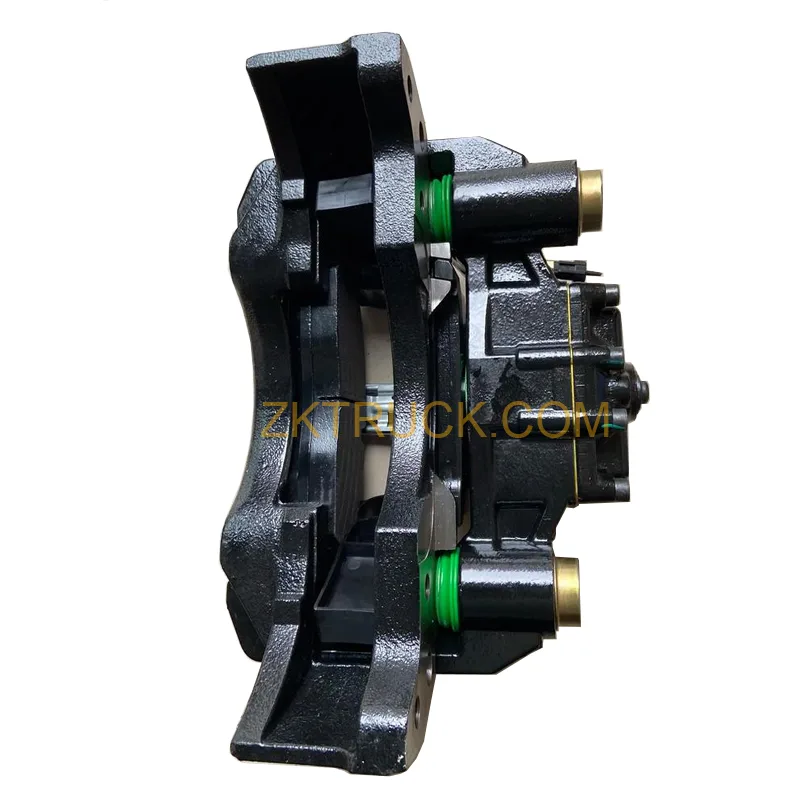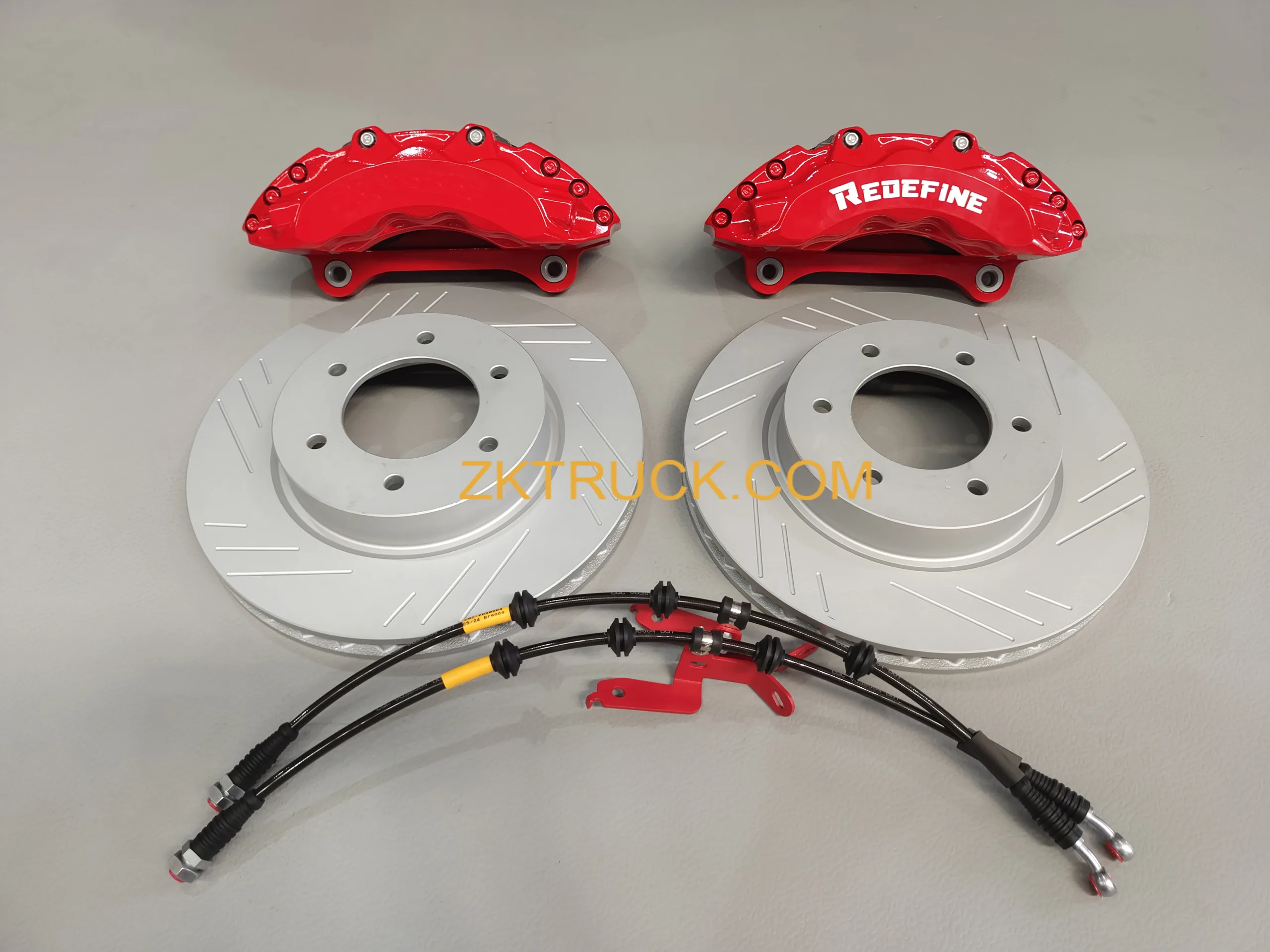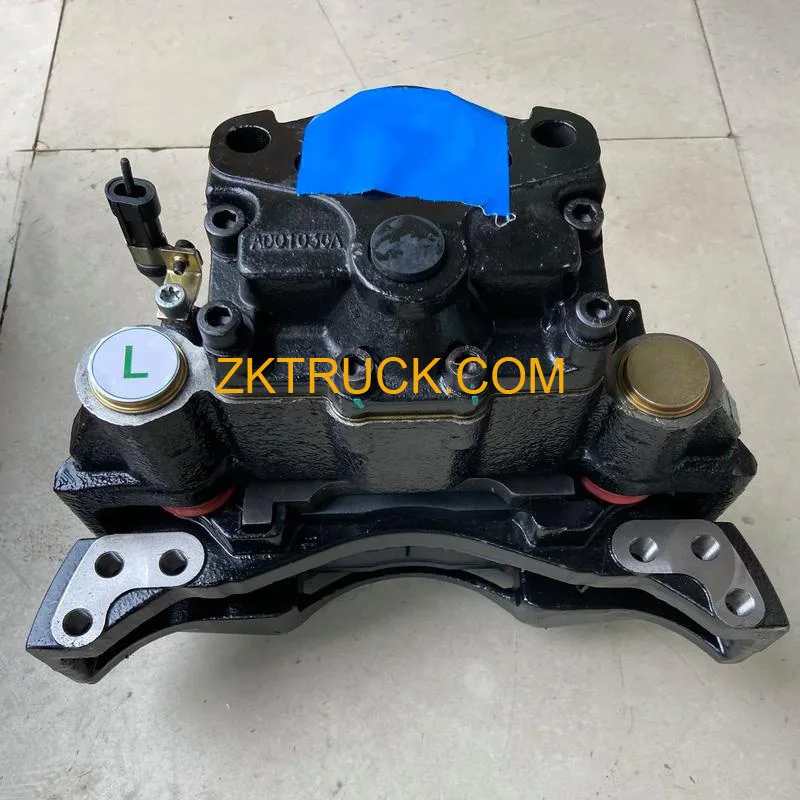The brake caliper is a crucial component in the braking system of heavy trucks, mainly used in disc braking systems (requiring cooperation with the brake disc). It clamps the brake pads to generate friction, enabling the vehicle to decelerate or stop. Let’s delve into it from aspects such as structure, working principle, faults, and maintenance:
Structure and working principle of the brake caliper:
- Core structure: It usually consists of the caliper body, piston, dust seal, oil seal, brake pads, etc.
- Caliper body: Made of aluminum alloy or cast iron, it is fixed on the steering shaft of the wheel or the axle of the vehicle to support the piston and brake pads.
- Brake pads: Installed inside the caliper, divided into inner and outer sides, they generate braking force through friction with the brakes and discs.
- Hydraulic piston: Connected to the brake line, receiving pressure from the brake fluid.
- Sealing: Allows the caliper to slide slightly during braking to ensure uniform force on both brake lining.
Working principle: Based on the hydraulic transmission principle, when the driver steps on the brake pedal, brake fluid enters the brake caliper, pushing the piston outward, and the inner brake pads directly press against the brake disc; simultaneously, under the hydraulic effect, the caliper moves inward, driving the outer brake pads to press against the other side of the brake disc. The friction force converts the truck’s kinetic energy into heat energy, achieving a reduction in vehicle speed until it comes to a stop.
When the hydraulic pressure disappears, the piston returns to its original position, and the brake pads and brake discs separate, releasing the braking.

The HOWO brakes and calipers had two types: floating type and fixed type. The floating type caliper (single piston) can move axially to ensure uniform force on both brake pads, providing more balanced braking force. The fixed type caliper uses a multi-piston design to ensure braking effect, reducing vehicle braking vibration and improving braking response speed.
Characteristics and advantages of the vehicle calipers:
- Strong braking force: HOWO trucks use large sized brake discs and high performance brake calipers, enabling rapid braking in emergency situations to ensure driving safety.
- Good heat dissipation performance: Some models are equipped with ventilated brake systems, where the caliper and the ventilated disc cooperate to effectively dissipate heat, ensuring excellent braking performance even in extreme temperatures.
- High reliability: The braking system of HOWO vehicles uses high quality brake components and advanced control systems. The brake caliper, as a key component, has high reliability, long lifespan, etc.
Common faults and manifestations of the brake caliper
Caliper not returning to position: Broken or lost elasticity of the return spring, stuck piston, incorrect fixation or installation of the rear axle bearing, worn rear axle bearing, etc. can all cause the caliper not to return to position, manifested as the brake pedal not returning to normal position and the vehicle possibly not being able to drive normally.
Sealing damage: Damaged sealing will cause brake fluid leakage, requiring replacement of the brake pump repair kit or replacement of the entire brake pump.
Caliper locking: This is a serious fault, presenting symptoms such as brake failure, soft braking, and abnormal braking sounds. Brake failure makes it impossible to stop the vehicle promptly and effectively when braking is needed; soft braking causes insufficient braking force when pressing the brake.
Uneven wear of brake pads: Abnormal friction of the brake pads may be the cause of abnormal braking sounds. Poor lubrication, deformed brackets, or uneven piston force issues.

The lifespan of the brake calipers:
- Under normal maintenance and without serious faults, their lifespan can reach 80,000 to 150,000 kilometers or 8 to 15 years. However, bad usage habits can significantly shorten their lifespan. Let’s analyze the factors that affect the lifespan of the vehicle’s brake calipers:
- Heavy load / Frequent braking: Vehicles such as trucks and buses that are heavily loaded or frequently brake for a long time have faster wear of pistons and seals, and their lifespan may be significantly shortened. Therefore, please strictly prohibit overloading.
- Harsh environment: Long-term driving on wet, dusty, or salty roads is prone to rust or being clogged by impurities, resulting in severe piston wear or jamming, and shortening the lifespan.
- Maintenance quality: Failure to clean the calipers regularly and replace the brake fluid may cause the internal structure to corrode due to deteriorated oil, or piston wear due to accumulated impurities.
How to maintain and service the brake calipers?
- Regular inspection: Regularly check if the pistons, oil seals, etc., are worn or leaking, and check the thickness of the brake pads. When the thickness of the brake pads approaches the limit value, it is necessary to replace them in time.
- Keep clean: Keep the inside and outside of the calipers clean and tidy to avoid impurities such as mud and dust from entering and affecting their normal operation.
- Pay attention to the brake fluid: Regularly check the level and quality of the brake fluid. Low level or deteriorated quality of the fluid will affect the performance of the entire braking system, and it is necessary to add or replace the brake fluid in time.

The brake calipers are the “executors” of the disc brake system, and their performance directly determines the sensitivity, stability and safety of braking. The control of the braking system by the driver, reasonable maintenance (regular inspection, cleaning, lubrication, etc.) is the protection of the entire braking system. It is also the most important guarantee for the driver’s own safety.
